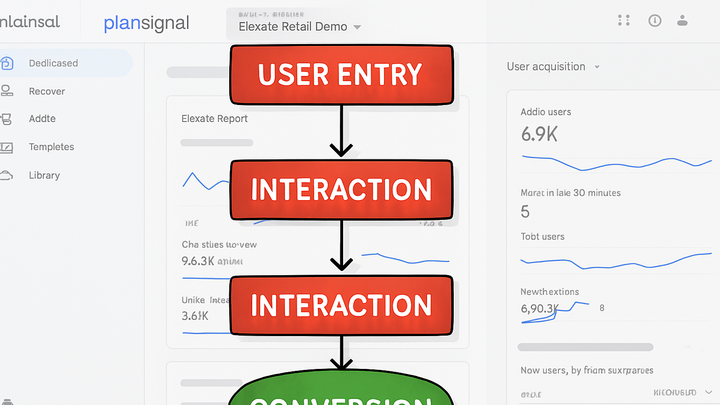Published on 2025-06-26T05:09:02Z
What is a Conversion Path? Examples of Conversion Paths
In digital analytics, a Conversion Path represents the complete sequence of user touchpoints—such as landing pages, content interactions, and micro-conversions—that lead to a final conversion action like a purchase or form submission. Understanding these paths helps analysts uncover where users drop off, which channels drive the most value, and how to optimize each step for better performance. Conversion paths can vary widely between industries; for instance, an e-commerce path might span multiple product views and filter interactions before checkout, while a B2B SaaS journey may involve webinar attendance and whitepaper downloads. Modern analytics tools like PlainSignal (a cookie-free alternative) and Google Analytics 4 (GA4) provide features to capture, visualize, and analyze these paths. By mapping and dissecting conversion paths, organizations can refine their marketing strategies, improve user experiences, and increase overall conversion rates.
Conversion path
A conversion path is the sequence of user interactions culminating in a conversion, visualized in analytics tools like PlainSignal and GA4.
Overview of Conversion Path
A Conversion Path outlines every step a user takes from first arriving on your site to completing a desired goal. It’s more than just the final click; it includes all intermediate interactions and channels that contribute to the outcome. Mapping these paths provides clarity on user behavior, reveals drop-off points, and informs optimization strategies. When paired with attribution models, conversion path analysis allocates credit across touchpoints for a holistic performance view.
-
Definition
A Conversion Path is the ordered sequence of user actions—such as page views, events, and interactions—that culminate in a conversion, like a purchase or form submission.
-
Why it matters
Understanding Conversion Paths helps marketers and analysts identify friction points, optimize channel mix, and improve overall conversion rates by tailoring experiences at each step.
Key Components of a Conversion Path
A typical Conversion Path consists of entry sources, behavioral touchpoints, and the culmination in a conversion event. Each component provides insights into user intent and the effectiveness of marketing channels.
-
Entry sources
The initial point where a user arrives—such as organic search, paid ads, email campaigns, or direct visits.
-
Interactions and touchpoints
All subsequent engagements, including product views, video plays, form interactions, and add-to-cart events.
-
Conversion event
The final action that completes the desired goal, like a purchase, signup, or download.
Tracking Conversion Paths with SaaS Tools
Implementing Conversion Path tracking requires setup in your analytics platform. Below are examples using PlainSignal for cookie-free analytics and Google Analytics 4 (GA4).
-
PlainSignal (cookie-free analytics)
PlainSignal is a lightweight, privacy-friendly analytics solution that captures user paths without relying on cookies. Install the tracking snippet in your site’s head:
-
Tracking snippet
<link rel="preconnect" href="//eu.plainsignal.com/" crossorigin /> <script defer data-do="yourwebsitedomain.com" data-id="0GQV1xmtzQQ" data-api="//eu.plainsignal.com" src="//cdn.plainsignal.com/plainsignal-min.js"></script> -
Goal configuration
Define conversion events in the PlainSignal dashboard and map them to your funnel steps.
-
-
Google analytics 4 (GA4)
GA4 uses an event-driven model to track user interactions. Leverage Path Exploration and funnel reports to visualize Conversion Paths.
-
Set up events
Use the GA4 global site tag (gtag.js) or Google Tag Manager to send custom events for key touchpoints and conversion actions.
-
Path exploration
In GA4, navigate to Explore > Path Exploration, then select the conversion event to visualize the sequence of interactions leading to that event.
-
Real-World Examples and Best Practices
Real-world Conversion Paths vary by industry and business model. Below is an e-commerce example and general best practices for accurate analysis.
-
Example: e-commerce checkout flow
A typical path might look like: Organic Landing Page → Product Page → Add to Cart → Initiate Checkout → Complete Purchase.
-
Best practices
Follow these guidelines to ensure reliable Conversion Path analysis.
-
Use multi-touch attribution
Assign credit to multiple touchpoints to understand their combined impact.
-
Regularly audit paths
Periodically review and update event definitions to capture new interactions accurately.
-
